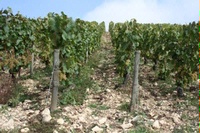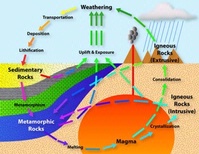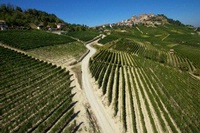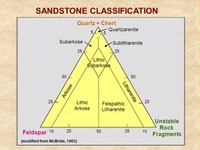|
|
 |

Rock types are important for understanding the geologic history of any given area. Wine enthusiasts and salespeople frequently refer to the rock types of a particular vineyard site with an air of importance that implies much greater certainty than a simple rock name can convey. The famous Kimmeridgian Clay/Limestone is part of the legend of Chablis. Students of the Langhe Hills revel in knowing which Barolo vineyards are on Tortonian Limestones and which on Serravalian (a.k.a. Helvetian) Sandstones. Additionally, the Willamette Valley of Oregon offers differences based on the composition of soils derived from volcanic rock vs. the sandstones and siltstones that comprise the marine sediments of the Willamette Valley AVA.

Chardonnay Vines Growing in the Biomicrite of Kimmeridgian Age in Chablis
How much meaning does a rock truly imply? We can find some answers by considering how rocks are classified. Rocks on earth are categorized according to the way they were formed. Igneous rocks are formed from cooled, molten lava or magma. Sedimentary rocks are formed by accumulation of sands, clays and gravels that are buried and compacted. Metamorphic rocks are in between -- exposed to intense heat and pressure sufficient to transform existing rocks into new rocks. The Rock Cycle shows how igneous rocks are formed, and then weathered to become sedimentary rocks, which are buried and metamorphosed by heat and pressure and sometimes re-melted to become igneous rocks again. All of the world’s rocks can be classified under these three categories.

The Rock Cycle
For simplicity, let’s just consider sedimentary rocks and delve deeper into the classification system. All sedimentary rocks are made from the components of other, pre-existing rocks that have been broken down, transported by water, wind, gravity or some other means, and reassembled into new rocks.
There is a further sedimentary rock classification based on the type of cementation that binds the new rock together. Rocks on the earth’s surface are subject to weathering -- the slow disintegration into their physical and chemical components. These weathered rocks lose their structural integrity and are broken down into fragments -- clasts in the geologic parlance. These fragments are most often transported by water but can be moved by wind, ice or landslides. They are eventually deposited, most often into a still water body where they accumulate.
Through a combination of burial, compaction, cementation, or crystallization, these fragments are transformed into new sedimentary rocks -- a process called lithification. When the cement that binds the clasts together is based on silicon, it’s called a siliciclastic rock. Sandstones, shales, siltstones and conglomerates are examples. An alternative cement is calcium carbonate. Calcium carbonate (CaCO3) is most often precipitated by organisms in seawater that build their shells from dissolved calcium carbonate in the water. In this case, the resulting crystalline rocks are known as biogenic sedimentary rocks. Limestones and dolomites are the primary biogenic sedimentary rocks.
We must consider as well, the depositional environments associated with rock types. In an oversimplified world, sediments would be deposited in a relatively orderly fashion. The sands and clays arrive as a mixture and are separated by physical processes. The sands are heavier and stay near the shoreline where they form beaches and, over millions of years, sandstones. The clay particles can be carried in suspension farther out to sea and settle to the bottom in quieter waters and will eventually form shales. Further out to sea, the calcium carbonate skeletons of plants and animals build up on the sea floor to form limestones.

A Simplified Diagram of Depositional Environments
In the real world, of course, nothing is this simple. The sands, silts and clays do not fully separate and are mixed together in all sorts of proportions. The limestones as well are intermixed with various proportions of gravels, sands, clays and the like. The end result is a complete spectrum of varying percentages of sediments mixed together. Thus, we can find sandy limestones, silty shales in a wide range of combinations.

Nebbiolo Vines growing on Calcareous Litharenite in La Morra
For classification, we must draw somewhat arbitrary lines and apply our nomenclature. This is when it gets really complicated. Classifications are often displayed as ternary diagrams, showing where the lines are drawn between rock types. There are subclassifications based on the content of the sandstone as well as the degree of compaction, and it is difficult to encompass all the variables in a single, two-dimensional diagram.

A Sandstone Classification Ternary Diagram
To return to the classification of our Barolo example, the soils of Serravalian age (formerly Helvetian) are formed from sandstones with a significant amount of rock fragments and some calcium carbonate cement. They can be classified as a Calcareous Litharenite. The soils of Tortonian age, while somewhat similar, have sufficient calcium carbonate to be classified as limestones. They do, however, have significant sand and clay components and could thus be classified as an Arenacous or Argillaceous Limestone. The subdividing can go on for another round or two beyond this, creating a nearly impenetrable vocabulary barrier to all but the most geologically inured.
There are many more subdivisions of rocks. Limestones have their own classification with a different nomenclature. Limestones are classified primarily by their matrix material -- from very fine-grained micrite to the obvious crystal content of a sparite. They are also subdivided by contents contained within the matrix, including fossils.

A Classification of Limestones Based on Matrix Material and Inclusions
So, we can see that the Kimmeridgian of Chablis, because it is laden with fossils in a fine matrix, might be called a Biomicrite. The limestones in St. Emilion have both fossils and more sand in the mix, so they might be assigned an Arenaceous Biomicrite designation. The vineyards in the Mt. Harlan AVA of California are noted for their limestone bedrock, but this is a crystalline limestone that contains some rock fragments, so it would be classified as an Intrasparite.
The classifications for igneous and metamorphic rocks are similarly complex, but the naming conventions are different, so a student of rock classification needs fluency in multiple dialects of scientific jargon. As wine lovers, we do not necessarily care whether our grapes are grown on a Lithic Subarkose Sandstone or an Oo-biosparite Limestone. We can recognize, however, that a simple rock name encompasses a wide range of real-world possibilities. Because a single rock name can mean so many different things, on its own it means very little and requires more specific elaboration.
|
 |
|